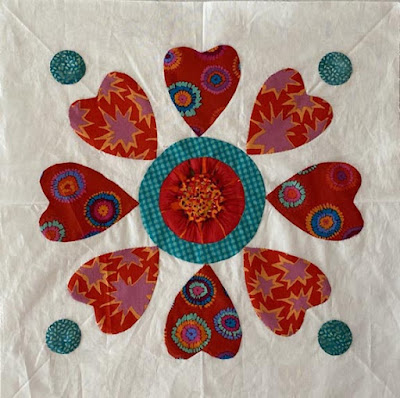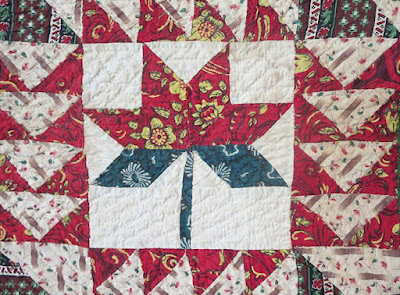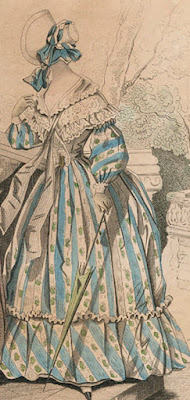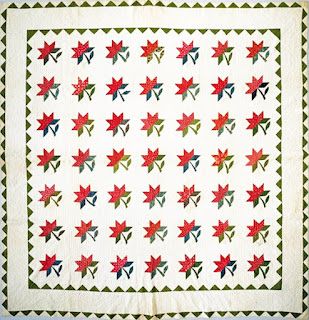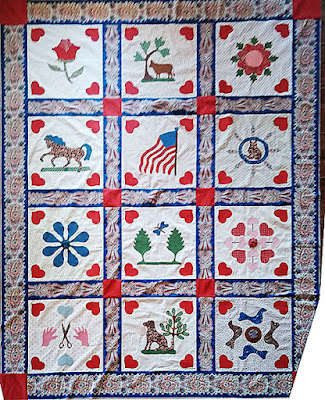Freedom's Friends #1
Circle of Friends by Georgann Eglinski
(with a few added dots to fill empty corners)
This year's Block of the Month for Civil War Quilts is
Freedom's Friends, recalling a group of Philadelphians, some like Lucretia Mott and
Robert Purvis, well-remembered; others less famous. The first block "A Circle of Friends" is for American hero Letitia George Still (1821-1908) almost
forgotten. Such obscurity may have pleased a woman who lived in a time when ladies
did not seek public recognition but hovered in the background.
Philadelphia in 1838
Many might not have viewed Letitia as a "lady:" She was born in Philadelphia of free Black parents. But when she died in her mid-80s her death certificate listed her occupation as Lady.
Letitia's 1908 death certificate was signed by her daughter
Dr. Caroline V. Anderson

We have no image of Letitia so an anonymous young woman working will serve as her portrait. Letitia and husband William Still ran a boarding house in an African-American neighborhood. William was employed as secretary and chair who ran the day-to-day activities of the Philadelphia Vigilance Committee, an arm of the Pennsylvania Anti Slavery Society (P.A.S.S.)
The 1859 Philadelphia City directory shows William managing a boarding house and working
in the offices of the Pennsylvania Anti-Slavery Society at 107 N. 5th. We know who actually ran the boarding house (see picture of woman working above.)
In 1854 William recorded a visit by Harriet Tubman,
a Maryland "conductor," as William termed people who assisted
fugitives on the road.
A biographer estimates: "Of all the African Americans that came through Philadelphia on the Underground Rail Road, ninety-five percent were welcomed into the Still household." [Maybe a bit overstated.]

Circle of Friends by Denniele Bohannon
While Letitia kept
house for numerous tenants, legal and illegal, and her own young children William
kept careful records of the fugitive slaves who sought help from the Anti-Slavery
Office. He rewrote his journal into a book he published in 1872, outlining the
stories of nearly 1,000 people who passed through Philadelphia.
In the book’s third edition William included a third-person autobiography,
devoting a long paragraph to his wife and complimenting her:
“How differently it all might have been had he not been blessed
with a wife, Letitia, who possessed like intuitions, who was equally ardent in
the cause, and always judicious and patient when emergency crossed her
threshold.”
In 1852 when their work began in earnest William and Letitia
had been married for about five years. She advertised as a dressmaker in 1851
and probably continued sewing to earn money until after the Civil War.
From the National Register application for the Still's home.
Their
eldest daughter Caroline Virginia, called Carrie by her mother, was born in 1848.
Letitia gave birth to at least six children, four of whom lived to adulthood. William
Wilberforce Still was born in 1854; Frances Ellen in 1857; Letitia 1861, Robert George in
1861; a stillborn girl followed in 1863.
The house, now 625 S. Delhi, with a new facade.
The marker is at
244 S. Twelfth Street
The sign and the house are not at the same location.
In 1861 as Civil War approached William resigned from the Anti-Slavery Office. Traffic in runaways was decreasing and his family of six
required more income. He opened a stove and range shop (modern technology at the time)
and bought a coal yard, both good investments.
Friends Intelligencer ad (a Quaker paper)
William's Circle of Friends endorsed his business in September, 1861.
The Motts, the McKims, Thomas Williamson, etc.---were all active
in the P.A.S.S.
After the U.S. Army established
the U.S. Colored Troops in 1863 William ran the post exchange at their Pennsylvania
training camp.
Drilling at Camp William Penn, north of Philadelphia
Library of Congress
Although William’s business prospered in the early 1860s and her work load was undoubtedly lighter with no fugitives to care for, Letitia’s Civil War years held much sadness including the death of 15-month-old Letitia from a concussion in 1862. Hopes to replace her resulted in the stillborn girl, never named, in 1863.
The Stills and their circle continued in the work of what we’d call Civil
Rights after the war. The Pennsylvania Anti-Slavery Society disbanded in May, 1871.
Collection of the Library Company of Philadelphia
Letitia and William had four children who survived into adulthood. William Wilberforce Still (1854–1932) was an attorney in Philadelphia with a degree from Lincoln University. Robert George (1861–1896) was a Philadelphia printer and journalist, Frances Ellen (1857–1943) a teacher.

The 1900 census finds Letitia, husband William, daughter Frances, son William and his wife living together with boarder Martha Franklin and a servant named Rose Johnson. Here Letitia's name is spelled Letilda.
Caroline Virginia Still Wiley Anderson (1848-1919)
Eldest daughter Caroline graduated from Oberlin College in 1868. Letters her mother wrote to her in Ohio are in the Charles L. Blockson Afro-American Collection at Temple University which holds many Still family papers.
Letitia's inconsistent spelling is at odds with her lovely handwriting.
Here she wishes Carrie were home:
"to help me get some new clothe[s] for myself.
I have plenty [of] old duds to ware round home."
A glimpse of her voice.
Caroline went on to get a medical degree from Philadelphia's
Women's Medical College in 1878.
Letitia, her husband and daughters are buried in Eden
Cemetery in Collingdale founded by African Americans a few years before her
death.
Many people with the surname George are buried there and some may be her
relatives.
Look for a free pattern for
Freedom's Friends on the last Wednesday of each month in 2022---and a true story about a woman in the Still's Circle of Friends.
The Block
Circle of Friends
Circle of Friends by Barbara Brackman
I finally remembered to put the pattern sheet up here.
Print it 8-1/2" x 11" and note the inch-square guide.
Mary Higgins, New Jersey, 1850
Garth's Auction
This year's applique blocks are drawn from album quilts made in the pre-Civil-War decades when the Stills were at the center of the fugitive slave network. Most quilts are from people in the Delaware Valley of Pennsylvania and New Jersey. This one was a gift for Mary Higgins (1811-1860) in Elizabeth Town, New Jersey. Many of the first album quilt makers were Quakers (also involved with the P.A.S.S.) but Mary seems to have been a Presbyterian.
Circle of Friends by Jeanne Arnieri
Jeanne's using stitchery and expanding on the original.
Letitia's husband William (1821-1902)
Historical Society of Pennsylvania
New Jersey "agent" Abigail Goodwin wrote William frequently and offered him advice in 1855:
"Thy wife must not sit up washing and ironing all night again. She ought to have help in her sympathy and labors for the poor fugitive, and, I should think there are many there who would willingly assist her."
In other words: Hire Some Help!
Circle of Friends by Becky Brown!
Further Reading & Watching
PBS did a video called Underground Railroad: The William Still Story, which aired in 2012.
You can still watch it with your PBS Passport. Check your local station.
1886 edition of William's book on line:


